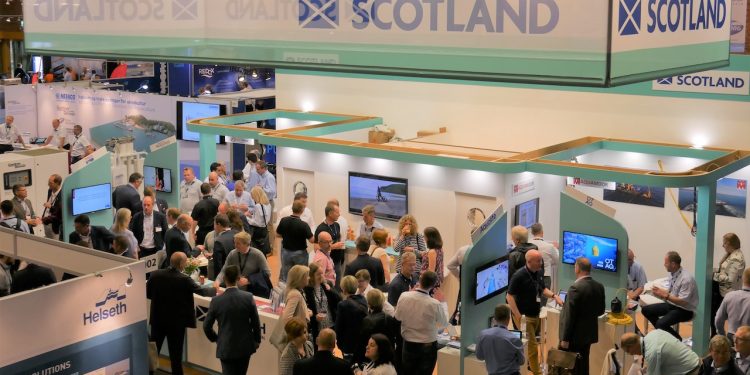A Scottish Government-backed delegation is travelling to Norway this week to showcase the strength of the country’s aquaculture supply chain and boost international trade opportunities for SMEs.
Some of Scotland’s latest aquaculture and marine technology is being showcased to an audience of 25,000 people from 75 countries at Aqua Nor – the world’s largest aquaculture technology trade fair. The event takes place in Trondheim this week and includes a Scottish pavilion attended by 18 of Scotland’s aquaculture supply chain businesses.
The Team Scotland presence at the event has been arranged by a partnership involving Highlands and Islands Enterprise (HIE), the Sustainable Aquaculture Innovation Centre (SAIC), and the Scottish Government.
‘The pavilion showcases the innovation, technology and research of Scottish aquaculture to an international audience and will create economic opportunities for the sector, including Scottish small and medium sized businesses,’ said Mairi Gougeon, Scotland’s Cabinet Secretary for Rural Affairs, Land Reform and Islands, who opened the pavilion at AquaNor.
‘Scotland’s aquaculture sector is a significant contributor to our economy, generating approximately £885 million GVA and an estimated 11,700 jobs while producing healthy and nutritious products. Our recently published Vision for Sustainable Aquaculture sets out our ambition to grow the sector, deliver innovation and makes clear the Scottish Government’s support for a sustainable aquaculture industry and supply chain.’
Companies joining the shared Scottish pavilion will have access to facilities for technical demonstrations, talks and networking, to support new commercial opportunities. A further 18 Scottish companies are joining the wider delegation with their own stands or as visitors to the event.
‘The return of the Scottish pavilion, bigger and better than ever before, is a fantastic platform for showcasing the impactful marine technology and innovation coming out of Scotland,’ said Heather Jones, CEO of SAIC.
‘Some of the SMEs joining the delegation may not have otherwise had the chance to come to Trondheim. This is why we have pulled together as Team Scotland, building on our role as a hub for connecting different areas of the sector and the academic community. I hope to see consultancy, new orders, and product and knowledge expertise exported from Scotland, contributing to our country’s international growth.’
Some of the Scottish marine technology on display includes OTAQ’s Live Plankton Analysis System (LPAS), which employs machine learning to automatically detect potentially harmful species of phytoplankton. GenusWave is also displaying its advanced audio signalling technology, which helps to protect salmon from predators.
Other organisations taking part are MiAlgae, Krucial, Moredun Scientific, Otter Ferry Seafish, Tritonia Scientific, Brimmond, SAMS Enterprise, I&C Process Solutions, KelpRing, Aqualife Services, Underwater Contracting, Veramaris, DSM-firmenich, Fish Farmer Magazine, Tritech and the University of Stirling’s Institute of Aquaculture.
As part of a busy three-day pavilion programme, a panel talk between representatives from Scotland, Norway, Canada and the Faroes will explore how different aquaculture-producing nations fund, drive, adopt and commercialise innovation to drive forward sustainable growth in aquaculture.
‘Aquaculture is an important industry in Scotland. In rural parts of the Highlands and Islands it creates opportunities for a broad and diverse range of businesses that provide vital year-round well-paid employment and support community resilience and prosperity,’ commented Elaine Jamieson, head of food and drink and life sciences at HIE.
‘Aqua Nor is the global meeting place for the industry and it’s great to be part of the team bringing together the Scottish pavilion. The event gives Scotland’s public and private sector the opportunity to showcase technology, innovation and products and services. Crucially, it also helps to explore new opportunities for international collaboration and trade, and will attract further inward investment to the Highlands and Islands.’









